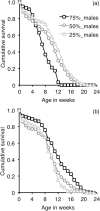Sex-specific patterns of senescence in artificial insect populations varying in sex-ratio to manipulate reproductive effort
- PMID: 32013878
- PMCID: PMC6998128
- DOI: 10.1186/s12862-020-1586-x
Sex-specific patterns of senescence in artificial insect populations varying in sex-ratio to manipulate reproductive effort
Abstract
Background: The disposable soma theory of ageing assumes that organisms optimally trade-off limited resources between reproduction and longevity to maximize fitness. Early reproduction should especially trade-off against late reproduction and longevity because of reduced investment into somatic protection, including immunity. Moreover, as optimal reproductive strategies of males and females differ, sexually dimorphic patterns of senescence may evolve. In particular, as males gain fitness through mating success, sexual competition should be a major factor accelerating male senescence. In a single experiment, we examined these possibilities by establishing artificial populations of the mealworm beetle, Tenebrio molitor, in which we manipulated the sex-ratio to generate variable levels of investment into reproductive effort and sexual competition in males and females.
Results: As predicted, variation in sex-ratio affected male and female reproductive efforts, with contrasted sex-specific trade-offs between lifetime reproduction, survival and immunity. High effort of reproduction accelerated mortality in females, without affecting immunity, but high early reproductive success was observed only in balanced sex-ratio condition. Male reproduction was costly on longevity and immunity, mainly because of their investment into copulations rather than in sexual competition.
Conclusions: Our results suggest that T. molitor males, like females, maximize fitness through enhanced longevity, partly explaining their comparable longevity.
Keywords: Ageing; Cost of reproduction; Disposable soma theory; Immunity; Immuno-senescence; Tenebrio molitor.
Conflict of interest statement
The authors declare that they have no competing interests.
Figures




References
-
- Stearns SC. The evolution of life histories. Oxford: Oxford University Press; 1992.
-
- Williams GC. Natural selection, the costs of reproduction, and a refinement of Lack’s principle. Am Nat. 1966;100:687–690. doi: 10.1086/282461. - DOI
Publication types
MeSH terms
Associated data
LinkOut - more resources
Full Text Sources
Other Literature Sources
Medical
Research Materials

